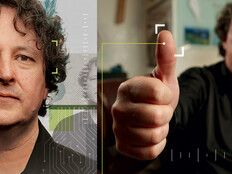Biometric Identifiers Methods Expanding With New Technology
Fingerprints have long been the most widely used biometric identifier, but technological advancements are helping to improve the usefulness of other biometrics, such as irises, palms, faces and even DNA.
Expanding the biometric palette for authenticators increases the likelihood of making a positive identification, even when a particular biometric may be incomplete or distressed, says Thomas Killion, director of the Defense Department’s Biometrics Identity Management Agency, based in Arlington, Va. Such improvements have expanded the ways that agencies can use biometrics.
Killion’s agency uses the Automated Biometric Identification System (ABIS), DOD’s database of biometric information, which includes a variety of identifiers. “We can combine and fuse iris, face and fingerprint information to sometimes identify an individual accurately where we would not have identified them if all we looked at were the individual modalities,” he says.
Performing such matches successfully would be impossible without a large database of biometric information, Killion says. A key element in building ABIS was the deployment of hardware in the field for collecting that information. “We’ve been using various systems in the field since around the 2005 timeframe,” he says. “ABIS has grown dramatically since that time.”
As the technology improves, Killion expects his agency to add more modalities, such as voice recognition, to its repertoire. “The broader the array of modalities that we can use, the more successful we will be in identifying individuals,” he says.
The FBI has been archiving fingerprints since 1924. What’s new for the bureau is the speed at which it can access and transmit its biometric data.
One of the earliest uses of biometrics was in Babylonia in 500 B.C., where business transactions were recorded in clay tablets that included fingerprints.
William M. Casey, program manager for the FBI’s Biometric Center of Excellence in Clarksburg, W.Va., recalls that before computer databases, local law enforcement officers used to ink three fingerprint cards for a suspect — one for the local police department, one for the state police and one for the FBI. “We’d mail the card to the FBI, and months later we’d get a response back from the FBI that the person was wanted someplace else,” he says.
“Now, we send fingerprints electronically from local and state police agencies and get a response, most times, within 20 minutes,” he says. “That’s a sea change for local police agencies. Instead of releasing a prisoner and months later trying to find him again, they’re at the booking desk when we get the response back.”
Traditionally, biometric information has been collected in the field by single-purpose devices, but that will change in the future, according to Killion. “We’re going to see more integration of biometrics into PDA devices,” he predicts. “That’s an advantage, because it reduces the burden on our soldiers because they don’t have to carry multiple devices.”







